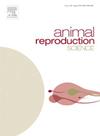Artificial intelligence in Andrological Flow cytometry: the next step?
IF 2.2
2区 农林科学
Q1 AGRICULTURE, DAIRY & ANIMAL SCIENCE
引用次数: 0
Abstract
Since its introduction in animal andrology, flow cytometry (FC) has dramatically evolved. Nowadays, many compartments and functions of the spermatozoa can be analyzed in thousands of spermatozoa, including, but not limited to DNA, acrosome, membrane integrity, membrane symmetry, permeability, and polarity; mitochondrial mass and mitochondrial membrane potential, identification of reactive oxygen species, ion dynamics, and cellular signaling among many others. Improved machines, many more probes, and new software are greatly expanding the amount of information that can be obtained from each flow cytometry analysis. Modern flow cytometers permit the simultaneous investigation of many different sperm compartments and functions and their interactions, allowing the identification of sperm phenotypes, helping to disclose different sperm populations within the ejaculate. Complex flow cytometry panels require a careful design of the experiment, including selecting probes (fully understanding the characteristics and properties of them) and adequate controls (technical and biological). Ideally, compensation and management of data (“cleaning”, transformations, the establishment of gates) are better performed post-acquisition using specific software. Data can be expressed as a percentage of positive cells (typically viability assays), intensity of fluorescence (arbitrary fluorescence units, i.e. changes in intracellular Ca2+) or dim and bright populations (typically assays of membrane permeability or antigen expression).
Furthermore, artificial intelligence/self-learning algorithms are improving visualization and management of data generated by modern flow cytometers. In this paper, recent developments in flow cytometry for animal andrology will be briefly reviewed; moreover, a small flow cytometry experiment will be used to illustrate how these techniques can improve data analysis.
人工智能在 Andrological 流式细胞仪中的应用:下一步?
自流式细胞术(FC)被引入动物和医学领域以来,它的发展突飞猛进。如今,可对数千个精子的许多区段和功能进行分析,包括但不限于 DNA、顶体、膜完整性、膜对称性、通透性和极性;线粒体质量和线粒体膜电位、活性氧的鉴定、离子动力学和细胞信号传导等。改进的机器、更多的探针和新软件大大增加了每次流式细胞仪分析所能获得的信息量。现代流式细胞仪可以同时检测许多不同的精子区室和功能及其相互作用,从而鉴定精子表型,帮助揭示射精中不同的精子群。复杂的流式细胞仪面板要求对实验进行精心设计,包括选择探针(充分了解探针的特性和属性)和适当的对照(技术和生物)。理想情况下,数据的补偿和管理("清洗"、转换、建立门)最好在采集后使用特定软件进行。数据可以用阳性细胞的百分比(通常是活力检测)、荧光强度(任意荧光单位,即细胞内 Ca2+ 的变化)或暗群和亮群(通常是膜通透性或抗原表达检测)来表示。此外,人工智能/自学算法正在改善现代流式细胞仪所生成数据的可视化和管理。本文将简要回顾流式细胞术在动物和医学方面的最新发展;此外,还将使用一个小型流式细胞术实验来说明这些技术如何改进数据分析。
本文章由计算机程序翻译,如有差异,请以英文原文为准。
求助全文
约1分钟内获得全文
求助全文
来源期刊

Animal Reproduction Science
农林科学-奶制品与动物科学
CiteScore
4.50
自引率
9.10%
发文量
136
审稿时长
54 days
期刊介绍:
Animal Reproduction Science publishes results from studies relating to reproduction and fertility in animals. This includes both fundamental research and applied studies, including management practices that increase our understanding of the biology and manipulation of reproduction. Manuscripts should go into depth in the mechanisms involved in the research reported, rather than a give a mere description of findings. The focus is on animals that are useful to humans including food- and fibre-producing; companion/recreational; captive; and endangered species including zoo animals, but excluding laboratory animals unless the results of the study provide new information that impacts the basic understanding of the biology or manipulation of reproduction.
The journal''s scope includes the study of reproductive physiology and endocrinology, reproductive cycles, natural and artificial control of reproduction, preservation and use of gametes and embryos, pregnancy and parturition, infertility and sterility, diagnostic and therapeutic techniques.
The Editorial Board of Animal Reproduction Science has decided not to publish papers in which there is an exclusive examination of the in vitro development of oocytes and embryos; however, there will be consideration of papers that include in vitro studies where the source of the oocytes and/or development of the embryos beyond the blastocyst stage is part of the experimental design.
 求助内容:
求助内容: 应助结果提醒方式:
应助结果提醒方式:


